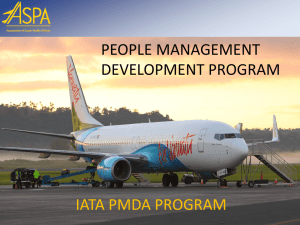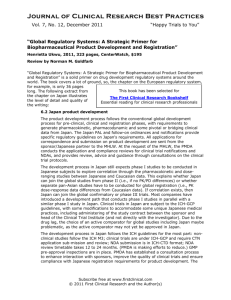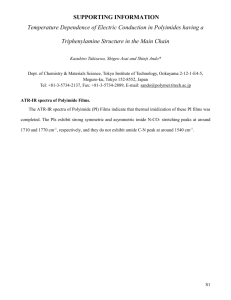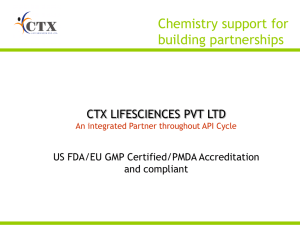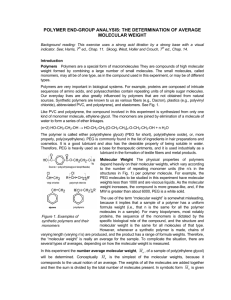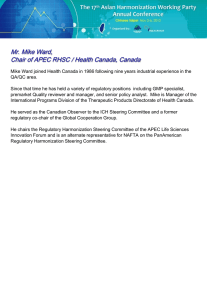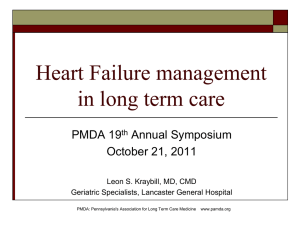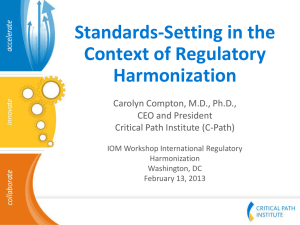December, 2014
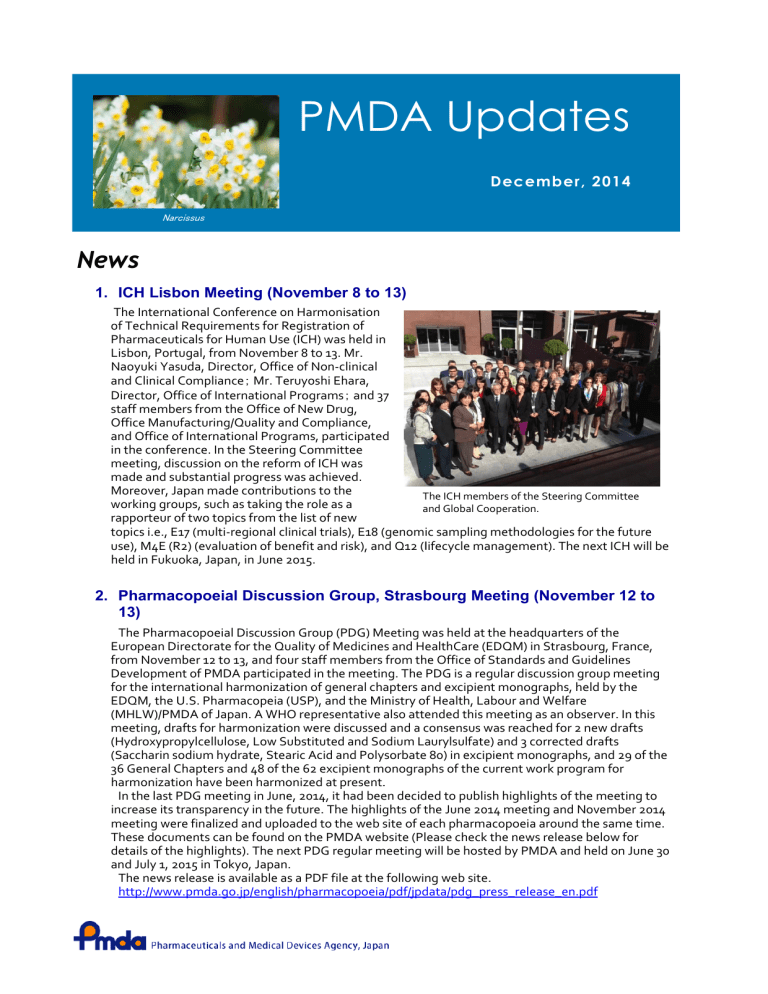
PMDA Updates
December, 2014
Narcissus
News
1. ICH Lisbon Meeting (November 8 to 13)
The International Conference on Harmonisation of Technical Requirements for Registration of
Pharmaceuticals for Human Use (ICH) was held in
Lisbon, Portugal, from November 8 to 13.
Mr.
Naoyuki Yasuda, Director, Office of Non ‐ clinical and Clinical Compliance ; Mr.
Teruyoshi Ehara,
Director, Office of International Programs ; and 37 staff members from the Office of New Drug,
Office Manufacturing/Quality and Compliance, and Office of International Programs, participated in the conference.
In the Steering Committee meeting, discussion on the reform of ICH was made and substantial progress was achieved.
Moreover, Japan made contributions to the
The ICH members of the Steering Committee working groups, such as taking the role as a and Global Cooperation.
rapporteur of two topics from the list of new
topics i.e., E17 (multi ‐ regional clinical trials), E18 (genomic sampling methodologies for the future use), M4E (R2) (evaluation of benefit and risk), and Q12 ( l ifecycle management).
The next ICH will be
held in Fukuoka, Japan, in June 2015.
2. Pharmacopoeial Discussion Group, Strasbourg Meeting (November 12 to
13)
The Pharmacopoeial Discussion Group (PDG) Meeting was held at the headquarters of the
European Directorate for the Quality of Medicines and HealthCare (EDQM) in Strasbourg, France, from November 12 to 13, and four staff members from the Office of Standards and Guidelines
Development of PMDA participated in the meeting.
The PDG is a regular discussion group meeting for the international harmonization of general chapters and excipient monographs, held by the
EDQM, the U.S.
Pharmacopeia (USP), and the Ministry of Health, Labour and Welfare
(MHLW)/PMDA of Japan.
A WHO representative also attended this meeting as an observer.
In this meeting, drafts for harmonization were discussed and a consensus was reached for 2 new drafts
(Hydroxypropylcellulose, Low Substituted and Sodium Laurylsulfate) and 3 corrected drafts
(Saccharin sodium hydrate, Stearic Acid and Polysorbate 80) in excipient monographs, and 29 of the
36 General Chapters and 48 of the 62 excipient monographs of the current work program for harmonization have been harmonized at present.
In the last PDG meeting in June, 2014, it had been decided to publish highlights of the meeting to increase its transparency in the future.
The highlights of the June 2014 meeting and November 2014 meeting were finalized and uploaded to the web site of each pharmacopoeia around the same time.
These documents can be found on the PMDA website (Please check the news release below for details of the highlights).
The next PDG regular meeting will be hosted by PMDA and held on June 30 and July 1, 2015 in Tokyo, Japan.
The news release is available as a PDF file at the following web site.
http://www.pmda.go.jp/english/pharmacopoeia/pdf/jpdata/pdg_press_release_en.pdf
PMDA Updates December, 2014
Page 2
3. The 7th Joint ChP-USP Science and Standards Symposium (November 13 to 14)
From November 13 to 14, the 7th Joint ChP ‐ USP Science and Standards Symposium was held, co ‐ hosted by the Chinese Pharmacopoeia Commission and the U.S.
Pharmacopeial Convention, in
Chengdu, China.
Dr.
Toshiyoshi Tominaga, Associate Executive Director (for International
Programs), and a staff member from the Office of Standards and Guidelines Development participated in the symposium as representatives from the Japanese Pharmacopoeia (JP), delivered a presentation and attended the panel discussion.
At this symposium that has been co ‐ hosted by ChP and USP since 2004, representatives from Pharmacopoeias in six countries/regions and over 400 general public participants attended and discussed the current status and future directions of
Pharmacopoeia in each participating country/region, and collaboration and international harmonization among Pharmacopoeias.
This symposium became a valuable opportunity to introduce JP to other countries.
On November 11, prior to the symposium, Dr.
Tominaga and the staff member visited the headquarters of ChP in Beijing, and had a bilateral meeting to exchange opinions on future
cooperative activities between JP and ChP.
4. DIA Japan 2014: The 11th Annual Meeting (November 16 to 18)
From November 16 to 18, DIA Japan 2014, the
11th Annual Meeting, was held in Tokyo under the theme of “The Dawn of Medical Innovation that Transcends Boundaries.” In the special session on the first day, Dr.
Tatsuya Kondo, Chief
Executive of PMDA and Prof.
John Skerritt,
National Manager of Therapeutic Goods
Administration (TGA), Australia delivered speeches.
A total of 34 staff members from
PMDA participated as session chairs or speakers.
In the PMDA Town Hall held on the last day, Ms.
Tomiko Tawaragi, Chief Safety Officer, chaired the panel; and Dr.
Emiko Kondo, Director, Office of Safety I; Dr.
Daisaku Sato, Director, Office of
Cellular and Tissue ‐ based Products; Mr.
Yasunori
From left: Dr.
Kondo, Prof.
Skerritt
Yoshida, Director, Office of Review Management; and other three staff members directly answered questions from the audience.
At the PMDA exhibition booth in the exhibition hall, staff members of the Office of International Programs communicated with visitors, distributed printed materials, and answered their questions.
The DIA Japan 2015, 12th Annual Meeting, will be held from November 15
to 17, 2015, in Tokyo, Japan.
5. 2014 AHWP Annual Meeting (November 18 to 21)
The annual meeting of the Asian Harmonization Working Party (AHWP) was held from November
18 to 21 in Seoul, Korea, and a staff member of the Office of International Programs participated in the meeting.
In the first two days, the joint workshop was co ‐ hosted by APEC Harmonization Center
(AHC) and AHWP, and in the session for introducing the respective regulatory affairs of APEC and
ASEAN member economies, and PMDA, PMDA gave a presentation on the outline of the review of medical devices in Japan.
In the following two days, progress reports from working groups of AHWP and a report from the International Medical Device Regulators Forum, where AHWP attends as an affiliate organization, were presented.
In addition, an election was conducted to select the chair, the vice chair and technical committee chairs of AHWP for the next term.
There were about 600 participants, and active discussions took place throughout the four days.
PMDA Updates December, 2014
Page 3
6. The 9th International Summit of Heads of Medicines Regulatory Agencies and ICMRA (November 19 to 21)
The 9th International Summit of Heads of Medicines Regulatory Agencies hosted by the Chinese
Food and Drug Administration (CFDA) was held in Beijing, China, from November 19 to 21.
Dr.
Tatsuya Kondo, Chief Executive; and Dr.
Toshiyoshi Tominaga, Associate Executive Director (of
International Programs) from PMDA; and Mr.
Masatoshi Narita, Councilor for Pharmaceutical Affairs,
Minister’s Secretariat; and Dr.
Nobumasa Nakashima, International Planning Director, International
Affairs Division, Minister’s Secretariat, concurrently assigned to Pharmaceutical and Food Safety
Bureau from MHLW; participated in the Summit.
The Summit is a meeting held annually among the heads of the regulatory agencies of pharmaceuticals to discuss various topics related to the regulation of pharmaceuticals.
In the summit, reviews of pharmaceuticals, Good Manufacturing
Practice (GMP) inspections, and Substandard/Spurious/Falsely ‐ labelled/Falsified/Counterfeit medical products (SSFFC) monitoring were discussed.
International Coalition of Medicines Regulatory
Authorities (ICMRA) was established to better safeguard public health by facilitating greater co ‐ operation.
Canada is the chair, and Ireland and Japan serve as vice chairs.
This time, future operation policy of ICMRA was discussed in the meeting.
7. PMDA provides JICA training program “Good Governance of Medicines for
National Pharmaceutical Regulatory Authorities” (November 21)
PMDA accepted twelve officers from Afghanistan, Iraq, Sri Lanka, Tanzania, China, Malaysia, and
Myanmar, and gave lectures on outlines of PMDA’s organization and international activities, quality management and Good Clinical Practice (GCP), post ‐ marketing safety measures, and relief for adverse health effects, etc.
on November 21.
This training was provided upon the request from Japan
International Corporation of Welfare Services (JICWELS), based on the contract between JICWELS and Japan International Cooperation Agency (JICA), which organized “Good Governance of
Medicines for National Pharmaceutical Regulatory Authorities”.
This was the third training course following the first in 2012, and the second in 2013.
8. AdvaMed training seminar (December 8 to 9, and December 11 to 12)
At the request of Advanced Medical Technology Association (AdvaMed), PMDA dispatched two staff members each from the Office of Manufacturing/Quality and Compliance and the Office of
International Programs as tutors, joining one member from MHLW, to the workshops hosted by
AdvaMed from December 8 to 9 in Washington D.C.
and from December 11 to 12 in San Francisco.
The aim of this seminar was to promote a better understanding among U.S.
manufacturers of the outline of “Act on Securing Quality, Efficacy and Safety of Pharmaceuticals, Medical Devices,
Regenerative and Cellular Therapy Products, Gene Therapy Products, and Cosmetics” (revised
Pharmaceutical Affairs Act), which was put into effect on November 25, details of QMS inspection under the new act, and review and consultation services for medical devices and in vitro diagnositcs.
Active discussions as well as an exchange of questions and answers took place during the workshops, indicating the high interest in the new Japanese act and pharmaceutical affairs administration among the U.S.
industries.
PMDA Updates December, 2014
Page 4
Events
Conferences/Meetings PMDA hosts or participates in:
Title
Date
January 26 CMC Strategy Forum January 2015
January 27 ‐ 29
The 19th Symposium on the Interface of Regulatory and
Analytical Sciences for Biotechnology Health Products
Location
Washington D.C.
Washington D.C.
February 2 ‐ 6
The 2nd PMDA Training Seminar
(Medical Devices)
February 23 Harmonization By Doing (HBD)
March 10 The 1st Japan ‐ Malaysia Symposium
Tokyo
Washington D.C.
Kuala Lumpur
March 24 ‐ 26 International Medical Device Regulators Forum (IMDRF) Tokyo
Safety Information
Pharmaceuticals and Medical Devices Safety Information No. 318,
November 25, 2014
1.
Simeprevir Sodium and Hyperbilirubinaemia
2.
Surveillance on Availability, Dissemination, and Utilization of Drug Safety Information in Medical
Institutions and Pharmacies
3.
Adverse Reactions to the Influenza Vaccine in the 2013 Season
4.
Important Safety Information
(1) Enzalutamide
(2) Teneligliptin hydrobromide hydrate
(3) Vancomycin hydrochloride (for injection)
(4) Simeprevir sodium
5.
Revision of Precautions (No.
260)
(1) Acetaminophen and vancomycin hydrochloride (oral dosage form)
6.
List of Products Subject to Early Post ‐ marketing Phase Vigilance (as of November 2014)
http://www.pmda.go.jp/english/service/precautions_2014.html
Notifications related to the revision of Pharmaceutical Affairs Act
1.
Guideline on Revision of Precautions and other information
http://www.pmda.go.jp/english/service/pdf/mhlw/PFSB ‐ SD ‐ 0929 ‐ 2.pdf
(English)
http://www.pmda.go.jp/operations/notice/2014/file/20140929 ‐ 2.pdf
(Japanese)
2.
Handling of Marketing Application for Combination Products http://www.pmda.go.jp/english/service/pdf/mhlw/PFSB ‐ ELD ‐ 1024 ‐ 2_PFSB ‐ ELD ‐ OMDE ‐ 1024 ‐
1_PFSB ‐ SD ‐ 1024 ‐ 9_PFSB ‐ CND ‐ 1024 ‐ 15.pdf
(English)
http://www.pmda.go.jp/operations/shonin/info/iryokiki/tsuchi/file/20141024 ‐ 2_20141024 ‐
1_20141024 ‐ 9_20141024 ‐ 15.pdf
(Japanese)
Additional posting of articles related to Post-marketing Safety to FAQ
1.
Post ‐ marketing Safety http://www.pmda.go.jp/english/service/faq.html
PMDA Updates December, 2014
Page 5
Reports from overseas
Our officers deliver lively reports of their activities at their stationed overseas authorities.
‐‐‐‐‐‐‐‐‐‐‐‐‐‐‐‐‐‐‐‐‐‐‐‐‐‐‐‐‐‐‐‐‐‐‐‐‐‐‐‐‐‐‐‐‐‐‐‐‐‐‐‐‐‐‐‐‐‐‐‐‐‐‐‐‐‐‐‐‐‐‐‐‐‐‐‐‐‐‐‐‐‐‐‐‐‐‐‐‐‐‐‐‐‐‐‐‐‐‐‐‐‐‐‐‐‐‐‐‐‐‐‐‐‐‐‐‐‐‐‐‐‐‐‐‐‐‐‐
Workshop on dose finding and dose selection for the successful development, licensing and lifecycle management of medicinal products
Utilization of modelling & simulation (M&S) was covered in the Reports from Overseas so far in terms of establishment of a Working Party (March 2013) and holding a Workshop (July 2014).
As already mentioned in my report in July 2014, an EMA ‐ EFPIA Workshop on the importance of dose finding and dose selection for the successful development, licensing and lifecycle management of
medicinal products, was held in 4 ‐ 5 December this year at EMA.
The workshop discussed the utility of methods for dosage/administration–exposure–response (D ‐
E ‐ R) relationship estimation and dose/administration finding, and the implications for the sponsor, the regulator, the prescriber and the patient if adequate information related to dose/administration are not generated.
As one of the regulatory authorities present, along with EMA and FDA, PMDA experts also gave a presentation regarding introduction of the current situation and cases in Japan, and future prospects.
Even in the same M&S field, it was particularly interesting for me to note the difference in approach for understanding target molecules in the well ‐ known relationship between antimicrobial agents and pathogenic micro ‐ organisms, compared to the less well known area of central nervous system drugs, where we are still researching the mechanism of function of receptors.
Video recordings of presentations and discussions in the workshop will be available on the
EMA website in early next year.
Needless to say, the field of M&S has attracted attention in recent years.
But what concrete results does M&S lead to?
It is expected that M&S will enable more accurate prediction such as relation between pharmacokinetics and clinical effects, dose ‐ response of clinical effects, outcome of disease, and prognosis.
Though M&S is already used in dose/response settings for pediatrics, we expect further utilisation of M&S in promoting development of medicines.
EMA will prepare a decision tree as a useful toolkit for both drug developers and regulators to guide methods such as model settings, which would lead to more qualified review in collaboration with regulatory authorities around the
world.
EMA Modelling and Simulation Working Group http://www.ema.europa.eu/ema/index.jsp?curl=pages/contacts/PDCO/people_listing_000123.jsp& mid=WC0b01ac058063f485
E.
Manolis et al., “The Role of Modeling and Simulation in Development and Registration of
Medicinal Products: Output From the EFPIA/EMA Modeling and Simulation Workshop”,
Pharmacometrics & Systems Pharmacology (2013) 2, e31 http://www.ncbi.nlm.nih.gov/pmc/articles/PMC3600760/pdf/psp20137a.pdf
EMA’s workshop held on 4 ‐ 5th December 2014 http://www.ema.europa.eu/ema/index.jsp?curl=pages/news_and_events/events/2014/06/event_de tail_000993.jsp&mid=WC0b01ac058004d5c3
EMA’s workshop held from 30th November to 1st December 2011 http://www.ema.europa.eu/ema/index.jsp?curl=pages/news_and_events/events/2011/07/event_det
‐ ail_000440.jsp&mid=WC0b01ac058004d5c3&murl=menus/news_and_events/news_and_events.jsp
Mr.
Yoshihiko Sano
PMDA’s International Liaison Officer stationed at EMA in the United Kingdom
‐‐‐‐‐‐‐‐‐‐‐‐‐‐‐‐‐‐‐‐‐‐‐‐‐‐‐‐‐‐‐‐‐‐‐‐‐‐‐‐‐‐‐‐‐‐‐‐‐‐‐‐‐‐‐‐‐‐‐‐‐‐‐‐‐‐‐‐‐‐‐‐‐‐‐‐‐‐‐‐‐‐‐‐‐‐‐‐‐‐‐‐‐‐‐‐‐‐‐‐‐‐‐‐‐‐‐‐‐‐‐‐‐‐‐‐‐‐‐‐‐‐‐‐‐‐‐‐
PMDA Updates December, 2014
Page 6
‐‐‐‐‐‐‐‐‐‐‐‐‐‐‐‐‐‐‐‐‐‐‐‐‐‐‐‐‐‐‐‐‐‐‐‐‐‐‐‐‐‐‐‐‐‐‐‐‐‐‐‐‐‐‐‐‐‐‐‐‐‐‐‐‐‐‐‐‐‐‐‐‐‐‐‐‐‐‐‐‐‐‐‐‐‐‐‐‐‐‐‐‐‐‐‐‐‐‐‐‐‐‐‐‐‐‐‐‐‐‐‐‐‐‐‐‐‐‐‐‐‐‐‐‐‐‐‐
Conclusion of Memorandum of Understanding (MoU) between Switzerland and the Republic of South Africa
Although the geographical distance between the Republic of South Africa and Switzerland is substantial, these two countries enjoy a close relation regarding a range of areas.
This relationship has just been further strengthened with a Memorandum of Understanding (MoU) regarding therapeutic products that was concluded between Swissmedic and the Medicines Control Council, the Republic of South Africa in October.
In the MoU, an agreement was reached on promotion of mutual understanding of regulatory framework and requirements, and exchanging and sharing information.
With execution of this MoU, both countries declare their intention to commence
proactive communication and cooperative activities.
In many countries in Africa, drug regulation is not as developed as Europe, the U.S.
and Japan.
Therefore, provision of essential medicines to protect public health is insufficient.
In order to overcome this situation, there is a movement to establish consolidated regulation on therapeutic product, known as the “African Medicines Regulatory Harmonization Initiative.” This activity aims at harmonization of requisites for drug review so that one medicine approved in any country in Africa becomes available in other African countries.
Regional Economic Communities (REC) are leading this activity.
The East African Community has finished its analysis of the current status in its participating countries, and the Southern African Development Community and some others are also following suit.
To disseminate ICH guidelines, these two REC are always invited to ICH meetings and they are familiar to me.
The Republic of South Africa, the most economically developed country in this continent, is expected to play a leading role in such an activity, and Switzerland will support the
Republic of South Africa in this context.
PMDA is establishing a collaborative relationship between South East Asian countries, and has deepened mutual understanding through co ‐ organizing seminars or accepting officials from regulatory agencies to PMDA training seminars.
Economic developments are still ongoing in some of the South East Asian and African countries and the purchasing power of their citizens is not as high as those in developed countries.
Under such circumstances, counterfeit medicine is easily available in their market.
One of the most important roles for the regulatory agency is to protect public health.
Supporting developing countries by transferring cultivated knowledge and experiences in pharmaceutical regulations will be our important role in international activities as a developed
agency.
Please refer to following web sites.
Swissmedic public statement and MoU https://www.swissmedic.ch/aktuell/00673/02485/index.html?lang=en https://www.swissmedic.ch/ueber/01398/01401/01936/02070/index.html?lang=de&download=NHz
LpZeg7t,lnp6I0NTU042l2Z6ln1acy4Zn4Z2qZpnO2Yuq2Z6gpJCDdoR6fmym162epYbg2c_JjKbNoK
Sn6A ‐‐
African Medicines Regulatory Harmonization Initiative http://amrh.org/
PMDA international activities http://www.pmda.go.jp/kokusai/events.html
Dr.
Jun Kitahara
PMDA’s International Liaison Officer stationed at Swissmedic in Switzerland
‐‐‐‐‐‐‐‐‐‐‐‐‐‐‐‐‐‐‐‐‐‐‐‐‐‐‐‐‐‐‐‐‐‐‐‐‐‐‐‐‐‐‐‐‐‐‐‐‐‐‐‐‐‐‐‐‐‐‐‐‐‐‐‐‐‐‐‐‐‐‐‐‐‐‐‐‐‐‐‐‐‐‐‐‐‐‐‐‐‐‐‐‐‐‐‐‐‐‐‐‐‐‐‐‐‐‐‐‐‐‐‐‐‐‐‐‐‐‐‐‐‐‐‐‐‐‐‐
PMDA Updates December, 2014
Page 7
‐‐‐‐‐‐‐‐‐‐‐‐‐‐‐‐‐‐‐‐‐‐‐‐‐‐‐‐‐‐‐‐‐‐‐‐‐‐‐‐‐‐‐‐‐‐‐‐‐‐‐‐‐‐‐‐‐‐‐‐‐‐‐‐‐‐‐‐‐‐‐‐‐‐‐‐‐‐‐‐‐‐‐‐‐‐‐‐‐‐‐‐‐‐‐‐‐‐‐‐‐‐‐‐‐‐‐‐‐‐‐‐‐‐‐‐‐‐‐‐‐‐‐‐‐‐‐‐
Measuring the effectiveness of risk minimization actions
As you may know, the Food and Drug Administration Amendments Act (FDAAA) of 2007 gave the
U.S.
FDA the authority to require a drug manufacturer to develop a risk evaluation and mitigation strategy (REMS) when the U.S.
FDA determines that a REMS is necessary to ensure that the benefits of a drug outweigh its risks.
However, you might not know that FDAAA also requires U.S.
FDA to bring, at least annually, one or more drugs with a REMS with elements to assure safe use (ETASU) before its Drug Safety and Risk Management (DSaRM) Advisory Committee to evaluate whether the elements 1) assure safe use of the drug, 2) are not unduly burdensome on patient access to the drug, and 3) to the extent practicable, minimize the burden on the healthcare delivery system.
To fulfill this requirement, U.S.
FDA convened a meeting of DSaRM Advisory Committee on November 18,
2014 to discuss the REMS for Soliris (eculizumab).
Please refer to detailed materials about this REMS and the DSaRM Advisory Committee meeting here:
( http://www.fda.gov/AdvisoryCommittees/Calendar/ucm417986.htm
).
I observed the DSaRM Advisory Committee meeting.
The presentations and discussion underscored for me the known difficulties of assessing the effectiveness of risk minimization action, such as a REMS.
Because there are usually limited usable data for assessing the impact of the actions in the real ‐ world clinical setting, there is no wellestablished method to evaluate these actions.
In
Japan, many drugs have been used with risk minimization actions, such as restricted distribution, or communication to patients and health care professionals.
While these actions seem like logical ways to manage the risks of drugs, the growing number and variety of risk minimization actions might be difficult to implement in clinical practice.
In light of this situation, Japan and the U.S.
might collaborate on further development of risk minimization assessment methodologies by exchanging experiences with risk minimization systems, even though the medical systems vary between the two countries.
Ms.
Shohko Sekine
PMDA’s International Officer at CDER, U.S.
FDA in the U.S.A.
‐‐‐‐‐‐‐‐‐‐‐‐‐‐‐‐‐‐‐‐‐‐‐‐‐‐‐‐‐‐‐‐‐‐‐‐‐‐‐‐‐‐‐‐‐‐‐‐‐‐‐‐‐‐‐‐‐‐‐‐‐‐‐‐‐‐‐‐‐‐‐‐‐‐‐‐‐‐‐‐‐‐‐‐‐‐‐‐‐‐‐‐‐‐‐‐‐‐‐‐‐‐‐‐‐‐‐‐‐‐‐‐‐‐‐‐‐‐‐‐‐‐‐‐‐‐‐‐
PMDA Updates
©2009 ‐ 2014 PMDA
PMDA Website: www.pmda.go.jp/english/
Contact: www.pmda.go.jp/english/contact/
